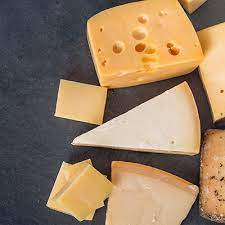Articles
Got Milk?
August 11, 2023

Part 3
Cheese
The first startling discovery one makes when watching the process of making cheese is that the liquid phase of milk is actually yellow. Of course, it isn’t the only one.
The cheese-making process is quite simple: You take fluid milk and add a coagulant, often a clone (vegetarian) rennet. This causes the protein (solids) phase of the milk to clump together (referred to as curds). The curds slowly sink to the bottom, and the yellowish whey remains on top. (By the way, this is referred to in hilchos Shabbos as m’gavin—making cheese (gevinah)—and is a toldah of boneh.) The whey is drained off and the curds are further processed into a solid, or they can be left as curds (as in cottage cheese). This is the 101 version.
There is a mindboggling variety of things that can be added. Certain cultures can be added at the coagulating stage to change the structure of the final product. Bacteria can be introduced to create different aromas. (Another by the way: The yellowish whey is frequently fractionated into different useful items. The most common of these is lactose [milk sugar], frequently used as an excipient in pills. Another is whey powder or whey protein powder, used in energy drinks. When you see these words in an ingredient panel, remember that they come from milk.)
In any case, the gezeirah of gevinas akum was formulated independently of the gezeirah of chalav akum, which means that even if you know clearly that a non-Jewish company had taken chalav Yisrael and created cheese using only kosher-certified rennet and cultures, it nonetheless would be gevinas akum if there were no involvement of a Yid, as prescribed in Halachah.
Furthermore, since many cheeses are manufactured at elevated temperatures, certainly requiring rigorous kashering, the level of expertise of the rav hamachshir is critical. Since it can take up to 10 pounds of milk (no, that was not a mistake—commercial milk is sold by the pound, not the gallon) to make one pound of cheese(!), this is a high-stakes game.
Most often, the cheese manufacturer has their own source of chalav Yisrael, adding an additional oversight burden to the hechsher.
In some cases, post-manufacture aging is involved, which requires rigorous oversight since most often, the aging facility is concurrent with nonkosher cheeses.
Then there are the packaging procedures. Remember, all this frequently takes place in locales where finding qualified mashgichim can be a challenge.
So, yes, it pays to be contemplative whom you will trust as the hechsher on your milk products.